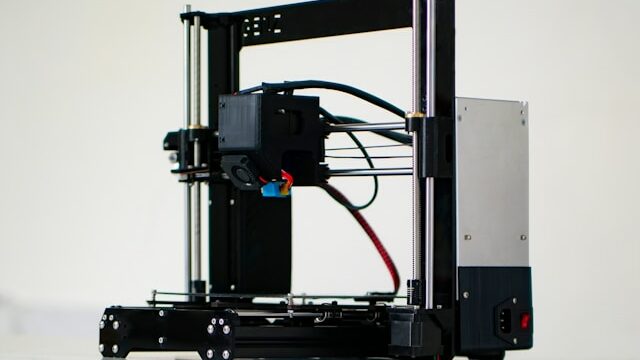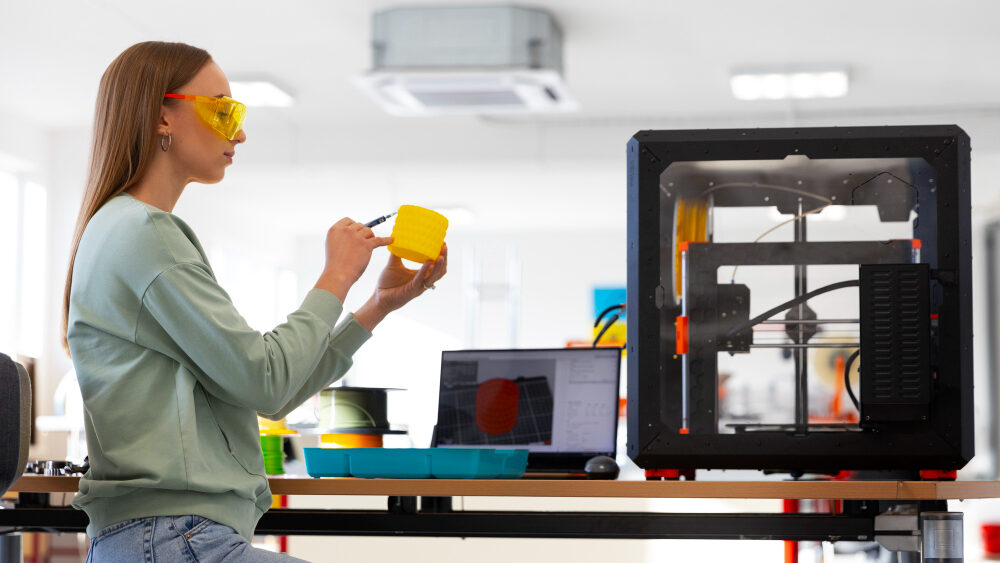Would you like to know more about the history of 3D printing to discover how it all began? At Imprimy, we are here to tell you about the beginnings of the adventure that is 3D printing.
The history of 3D printing began in the 1980s with Charles Hull’s invention of stereolithography, evolving from a rapid prototyping technology to an industrial and creative revolution thanks to advances in materials, software, and the emergence of the maker movement.

What are the origins of 3D printing?
The origins of 3D printing date back to the 1980s when Charles Hull invented stereolithography, a technique for creating objects layer by layer from digital models.
The technological context at the origins of 3D printing
3D printing, also known as additive manufacturing, has its origins in a technological context marked by significant advancements in several fields.
During the 1980s, progress in computing and robotics played a crucial role, enabling the development of machines capable of creating objects layer by layer from digital models.
Additionally, CAD (Computer-Aided Design) software also evolved, making it more accessible to create complex 3D models.
The pioneers of 3D printing
The pioneers of 3D printing played a crucial role in the development and popularization of this revolutionary technology. Among them, Charles Hull is often considered the father of 3D printing for inventing stereolithography in 1984 and founding the company 3D Systems.
Another notable pioneer is Scott Crump, who developed Fused Deposition Modeling (FDM) technology in the 1980s and co-founded Stratasys, a major company in the field of 3D printing.
Carl Deckard and Joe Beaman also made significant contributions with the development of Selective Laser Sintering (SLS) at the University of Texas at Austin.
All these innovators laid the foundations for the various 3D printing techniques used today, paving the way for applications in sectors ranging from aerospace to medicine.
How did the industrial maturation of 3D printing take place?
The industrial maturation of 3D printing has taken place in stages, with significant advances in materials and printing technologies, allowing its adoption in various sectors such as aerospace, automotive, and healthcare, while becoming more accessible due to cost reduction and open innovation.
The development of professional uses of 3D printing
The development of professional uses of 3D printing began to take shape shortly after the invention of the first 3D printing technologies in the 1980s. Initially, these technologies were used for rapid prototyping, allowing companies to create physical models of their designs in record time, thereby reducing development costs and lead times. The aerospace and automotive sectors were among the first to adopt 3D printing for these applications, as it offered the ability to quickly test and iterate on complex designs.
The first evolutions of 3D printing technologies
Throughout the 1990s and early 2000s, 3D printing began to be used for more advanced applications, including the production of final parts. Advances in materials, such as high-performance polymers and metals, enabled the use of 3D printing to produce functional components capable of withstanding rigorous conditions. This paved the way for applications in fields such as medicine, where 3D printing is used to create customized implants and prosthetics, and architecture, where it allows for the construction of detailed models and complex structures.
Additionally, 3D printing found applications in sectors such as education, where it is used to create anatomical models or educational tools, and scientific research, where it facilitates the creation of customized experimental devices.
When did 3D printing make its way to the general public?
3D printing began to make its way to the general public in the early 2010s, thanks to the democratization of technologies and the reduction in the cost of printers, as well as the emergence of the maker movement and collaborative spaces.
The end of key patents
The end of key patents for 3D printing marked a significant turning point in the evolution and democratization of this technology.
Several fundamental patents, including those covering technologies such as stereolithography (SLA) and fused deposition modeling (FDM), began to expire in the early 2010s. This includes the patent by Charles Hull for stereolithography, filed in the 1980s. Its expiration allowed other companies to develop and market 3D printers using this technology without fear of patent infringement lawsuits.
The expiration of these patents led to a significant increase in innovation and competition in the 3D printing sector. New companies were able to enter the market, offering more affordable and accessible 3D printers to consumers and small businesses. This also stimulated the development of new materials and software, expanding the application possibilities of 3D printing.
Furthermore, the expiration of patents fostered the growth of the open-source community around 3D printing. Projects like RepRap, which aim to create self-replicating and open-source 3D printers, benefited from this new freedom, allowing users to build and modify their own 3D printers. This dynamic not only reduced costs but also accelerated the pace of innovation in the field.
The emergence of the maker movement
The emergence of the maker movement, which surfaced in the early 2000s, represents a significant cultural and technological evolution, closely linked to the rise of 3D printing and other digital fabrication technologies. This movement is characterized by a community of individuals, known as “makers”, who share a passion for creation, innovation, and DIY projects. Makers utilize a variety of tools and technologies, including 3D printing, microcontrollers like Arduino, and electronic prototyping platforms like Raspberry Pi, to design and manufacture objects independently.
The increasing accessibility of digital fabrication technologies, partly due to the expiration of key patents and the reduction in equipment costs, played a crucial role in the growth of the maker movement. Collaborative spaces, known as makerspaces or fablabs, began to emerge worldwide, providing individuals with access to tools and resources to bring their ideas to life. These spaces foster collaboration, hands-on learning, and knowledge sharing, thereby creating a culture of open innovation.
The maker movement has also been supported by the philosophy of Do It Yourself (DIY) and open source, which advocate for the freedom to create, modify, and share designs and ideas. This approach has enabled makers to build upon each other’s work, thereby accelerating the pace of innovation and creativity.
Furthermore, the maker movement has had a significant impact on education by encouraging practical and interdisciplinary learning. It has also influenced the business world, with the emergence of startups and companies leveraging digital fabrication technologies to create new products and services.
How is 3D printing evolving today and in the future?
3D printing is evolving today with advances in artificial intelligence and new materials, promising a revolution in local production and creativity for tomorrow through optimized supply chains.
A Cross-Disciplinary Technology
3D printing has established itself as a cross-disciplinary technology, influencing and transforming a wide range of sectors thanks to its ability to produce complex objects with precision and flexibility.
- In the healthcare field, it has revolutionized the creation of custom prosthetics and implants, improving patients’ quality of life. Surgeons also use 3D-printed models to plan complex operations, reducing both risks and intervention time.
- In the aerospace industry, 3D printing enables the production of lightweight and durable parts, optimizing aircraft performance and lowering production costs.
- The automotive sector also benefits from this technology, which speeds up prototyping and allows for the creation of spare parts and custom components.
- In architecture and construction, 3D printing opens new possibilities for building innovative and sustainable structures, while reducing construction waste.
- Designers and artists use this technology to push the limits of creativity, producing complex and customized works that would be difficult—or even impossible—to achieve with traditional methods.
- Education is another field where 3D printing has a significant impact, offering students a hands-on and interactive learning experience by creating models and prototypes to illustrate theoretical concepts.
- Finally, in scientific research, 3D printing is used to develop custom instruments and experimental devices, thus facilitating discovery and innovation.
Challenges and Future Prospects of 3D Printing
While 3D printing offers numerous opportunities, it still faces several challenges before it can fully realize its potential. One of the main obstacles is the limitation of materials. Although the range of available options has significantly expanded, the materials used in 3D printing do not always have the necessary mechanical, thermal, or chemical properties required for certain industrial applications. Additionally, the cost of 3D printers and materials can be prohibitive, especially for small businesses or individuals.
Another major challenge is the production speed. Compared to traditional manufacturing methods, 3D printing can be slow, which limits its use in mass production. The quality and finish of 3D-printed parts can also be problematic, with issues related to precision, strength, and the appearance of the final objects.
Intellectual property is another concern, as 3D printing makes it easier to reproduce and distribute protected designs without authorization. This raises complex issues about copyright protection and the regulation of how these technologies are used.
However, the future prospects of 3D printing are promising. Advances in research and development could lead to the creation of new materials that are both higher-performing and more affordable. Improvements in printing technologies, such as increased speed and accuracy, could also expand the range of possible applications.
The integration of 3D printing with other emerging technologies, such as artificial intelligence and the Internet of Things (IoT), could unlock new possibilities for automation and customized production. For instance, AI could optimize designs for 3D printing, while IoT could enable real-time monitoring and control of manufacturing processes.
Conclusion : the History of 3D Printing
The history of 3D printing is marked by a rapid and transformative evolution, from its beginnings in the 1980s to its current status as a revolutionary and cross-disciplinary technology. Invented by pioneers like Charles Hull, who introduced stereolithography, this technology quickly captured industry interest for rapid prototyping, offering unprecedented opportunities to reduce costs and development time. Over the decades, 3D printing has evolved far beyond its original uses, driven by major advances in materials, software, and printing techniques.
The expiration of key patents in the early 2010s played a crucial role in the democratization of 3D printing, enabling many companies and individuals to innovate and bring their ideas to life. This also sparked the rise of the maker movement, a dynamic community that values creativity, collaboration, and knowledge sharing. Makerspaces and fablabs have become vital hubs for experimentation and learning, showcasing how 3D printing empowers people to become active creators.
Today, 3D printing is a cross-cutting technology that influences multiple sectors, from healthcare to aerospace, automotive, architecture, and beyond. It provides innovative solutions to complex challenges, such as the creation of custom medical prosthetics or the building of sustainable architectural structures. However, despite its many achievements, 3D printing still faces challenges, particularly regarding materials, production speed, and intellectual property.
The future outlook for 3D printing is promising, with potential breakthroughs in research and development of new materials, integration with other emerging technologies like artificial intelligence, and the optimization of supply chains. As it continues to evolve, 3D printing holds the potential to further revolutionize how we design, manufacture, and interact with the world around us.
Picture by Keyvan Max from Unsplash
The articles published on Imprimy.com are for informational purposes only. They are intended to provide general advice and information related to 3D printing. Imprimy.com cannot be held responsible for the results obtained or the consequences arising from the application of the shared information. We recommend always checking the specific instructions for your hardware and materials before use.


